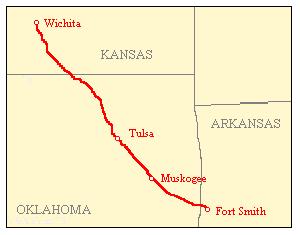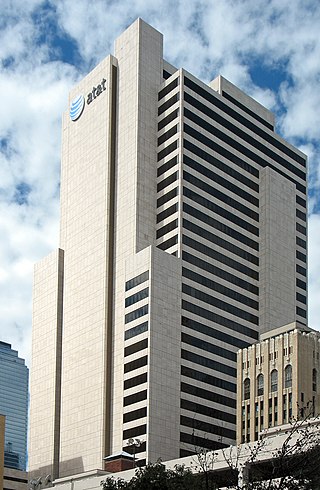
A Regional Bell Operating Company (RBOC) was a corporate entity created as result of the antitrust lawsuit by the U.S. Department of Justice against the American Telephone and Telegraph Company (AT&T) in 1974 and settled in the Modification of Final Judgment on January 8, 1982.

AT&T Teleholdings, Inc., formerly known as Ameritech Corporation, is an American telecommunications company that arose out of the 1984 AT&T divestiture. Ameritech was one of the seven Regional Bell Operating Companies that was created following the breakup of the Bell System. Ameritech was acquired in 1999 by SBC Communications, which subsequently acquired AT&T Corporation in 2006, becoming the present-day AT&T.
Pacific Telesis Group (PacTel) was one of the seven Regional Bell Operating Companies, sometimes also referred to as "RBOCs" or "Baby Bells", created in 1983 in preparation of the breakup of AT&T Corporation. Pacific Telesis was the holding company for Pacific Bell, Nevada Bell, Pacific Telesis International, PacTel Mobile Services and PacTel InfoSystems. Pacific Telesis was headquartered in San Francisco and incorporated in Nevada. It was acquired by SBC Communications in 1997, which would eventually become today’s AT&T Inc.
Cellular One is the trademarked brand name that licenses services used by several cellular service providers in the United States. The brand was sold to Trilogy Partners by AT&T in 2008 shortly after AT&T had completed its acquisition of Dobson Communications. Cellular One was originally the trade name of one of the first mobile telephone service providers.

The St. Louis Southwestern Railway Company, known by its nickname of "The Cotton Belt Route" or simply "Cotton Belt", is a former Class I railroad that operated between St. Louis, Missouri, and various points in the U.S. states of Arkansas, Tennessee, Louisiana, and Texas from 1891 to 1980, when the system added the Rock Island's Golden State Route and operations in Kansas, Oklahoma, and New Mexico. The Cotton Belt operated as a Southern Pacific subsidiary from 1932 until 1992, when its operation was assumed by Southern Pacific Transportation Company.

The breakup of the Bell System was mandated on January 8, 1982, by a consent decree providing that AT&T Corporation would, as had been initially proposed by AT&T, relinquish control of the Bell Operating Companies, which had provided local telephone service in the United States. This effectively took the monopoly that was the Bell System and split it into entirely separate companies that would continue to provide telephone service. AT&T would continue to be a provider of long-distance service, while the now-independent Regional Bell Operating Companies (RBOCs), nicknamed the "Baby Bells", would provide local service, and would no longer be directly supplied with equipment from AT&T subsidiary Western Electric.

Nevada Bell Telephone Company, originally Bell Telephone Company of Nevada, is a Nevada telephone provider and it was the Bell System's telephone provider in Nevada. It only provides telephone services to 30% of the state, essentially all of the state outside Las Vegas, where service is provided by CenturyLink. Nevada Bell spent nearly all of its history as a subsidiary of Pacific Bell, which is the reason Nevada Bell was not listed in Judge Harold Greene's Modification of Final Judgment, starting the breakup of AT&T.
VTech Innovation, L.P., doing business as Advanced American Telephones, is a telephone manufacturing company.

The Midland Valley Railroad (MV) was a railroad company incorporated on June 4, 1903 for the purpose of building a line from Hope, Arkansas, through Muskogee and Tulsa, Oklahoma to Wichita, Kansas. It was backed by C. Jared Ingersoll, a Philadelphia industrialist who owned coal mining properties in Indian Territory. The railroad took its name from Midland, Arkansas, a coal mining town in western Arkansas, which was served by the railroad. The Midland Valley gained access to Fort Smith, Arkansas via trackage rights over the Frisco from Rock Island, Oklahoma.
Indiana Bell Telephone Company, Incorporated, is the Bell Operating Company serving Indiana. It is an indirect subsidiary of AT&T Inc., owned by AT&T Teleholdings.
Frontier Southwest Incorporated is a Frontier Communications operating company in Texas. At its peak, Frontier Southwest served Arkansas, Oklahoma, Texas, and New Mexico.
Qwest Corporation is a Regional Bell Operating Company owned by Lumen Technologies. It was formerly named U S WEST Communications, Inc. from 1991 to 2000, and also formerly named Mountain States Telephone and Telegraph Company, known as Mountain Bell from 1911 to 1991. It includes the former operations of Malheur Bell, Northwestern Bell and Pacific Northwest Bell as well.

YP Holdings, now a wholly owned subsidiary of DexYP, is the American parent company for YP LLC. Its products include printed telephone directories, yp.com and YP app. YP offers local search, display ads and direct marketing. On July 31, 2012, YP was included in PaidContent50's list of "the world's most successful digital media companies" based on 2011 digital ad revenue.
YP Texas Region Yellow Pages LLC is a division of YP Holdings that publishes telephone directories to Southwestern Bell customers for AT&T.
SBC Long Distance LLC is a long-distance telephone company owned by AT&T that does business as AT&T Long Distance. SBC Long Distance competes with other long-distance providers who provide service within some of the Bell Operating Company service boundaries of AT&T. SBC Long Distance is a separate subsidiary than AT&T Communications, the incumbent long-distance carrier for most of the country acquired in the SBC merger with AT&T.
SBC Telecom, Inc. d/b/a AT&T Small Business is a CLEC owned by AT&T that offers local telephone service outside the AT&T Bell Operating Company regions. It was formed in 1999 following provisions that required SBC Communications to offer telephone service outside its boundaries in order to get approval to merge with Ameritech.

AT&T Inc. is an American multinational telecommunications holding company headquartered at Whitacre Tower in Downtown Dallas, Texas. It is the world's fourth-largest telecommunications company by revenue and the largest wireless carrier in the United States. As of 2023, AT&T was ranked 13th on the Fortune 500 rankings of the largest United States corporations, with revenues of $120.7 billion.
AT&T refers to several related companies providing telecommunications services:

The Bell System was a system of telecommunication companies, led by the Bell Telephone Company and later by the American Telephone and Telegraph Company (AT&T), that dominated the telephone services industry in North America for over 100 years from its creation in 1877 until its antitrust breakup in 1983. The system of companies was often colloquially called Ma Bell, as it held a vertical monopoly over telecommunication products and services in most areas of the United States and Canada. At the time of the breakup of the Bell System in the early 1980s, it had assets of $150 billion and employed over one million people.















